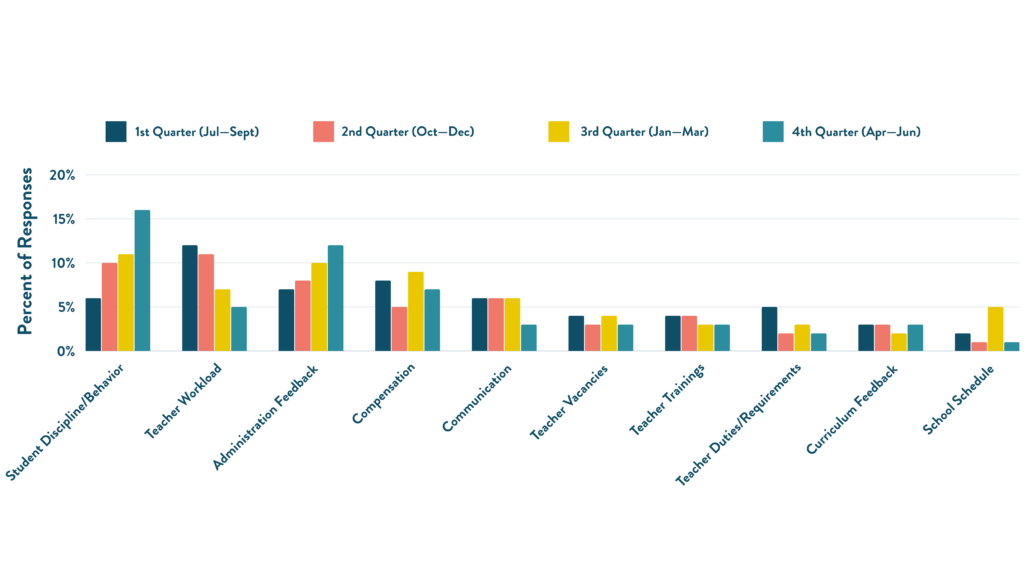As we analyze data from our Possip Pulse Checks®, we’ve learned that student behavior, discipline and bullying leads as the top staff feedback trend across the country. Concerns about student behavior and discipline affect staff morale.
Possip teammates present ideas for every school level to support teacher and staff concerns about student discipline and bullying.
At Possip’s webinar, “Sustaining Strong Schools: Strategies for Teacher and Staff Retention”, we noted that student discipline and bullying is a top concern throughout the year that increases every quarter. As shown in the graph below, we know this trend grows throughout the year.

What can administrators do now to curb the trend and reduce staff attrition? Working at a school level can help support teachers as they work with their students. Effective discipline strategies and implementing anti-bullying programs create a better teaching environment, leading to higher job satisfaction and retention.
Here are strategies for implementing effective discipline and anti-bullying programs in elementary, middle, and high schools:
Elementary School: Building Foundations of Respect and Empathy
Positive Behavior Support Systems (PBSS):
- Implement a school-wide PBSS or Positive Behavioral Interventions and Supports (PBIS) system that rewards positive behaviors and sets clear expectations. Use visual aids and interactive activities to teach these behaviors.
- Innovation: Incorporate gamification elements into the PBSS. For instance, use a points system where students earn rewards for positive behaviors, like helping others or resolving conflicts peacefully.
- Benefit: Encourages positive behavior from an early age, making discipline more about learning good habits than punishment. For more, check out this post on how a teacher integrated this theory into her classroom: Classroom Management Success With PBIS.
Social-Emotional Learning (SEL) Programs:
- Integrate SEL into the curriculum, focusing on empathy, emotional regulation, and interpersonal skills.
- Innovation: Use storytelling and role-playing activities to teach empathy and understanding. Implement peer-led discussions where students can share experiences and learn from each other.
- Benefit: Builds a foundation of empathy and respect, essential for preventing bullying and promoting healthy social interactions.
Middle School: Fostering Responsibility and Peer Support
Peer Mediation Programs:
- Train students to act as mediators in conflicts among their peers. This approach empowers students to take responsibility and resolve issues constructively.
- Innovation: Develop an app or digital platform where students can request mediation or advice anonymously.
- Benefit: Promotes a sense of responsibility and enhances problem-solving skills among students, reducing reliance on adult intervention.
Digital Citizenship Education:
- As cyberbullying is prevalent at this age, integrate digital citizenship education into the curriculum to teach responsible online behavior.
- Innovation: Create interactive online modules and simulations that guide students through scenarios involving digital etiquette and cyberbullying.
Benefit: Prepares students for the digital world, teaching them to be respectful and safe online. Google offers a free program for children: Interland: Be Internet Awesome that does not require logins to get started.
High School: Empowering Student Leadership and Community Involvement
Student Leadership in Anti-Bullying Initiatives:
- Encourage students to lead anti-bullying campaigns and mentor younger students. This could include organizing events, workshops, or social media campaigns.
- Innovation: Develop a student-led podcast or video series discussing bullying, mental health, and inclusivity.
- Benefit: Empowers students to be change-makers, fostering a school culture that actively opposes bullying.
Restorative Justice Practices:
- Implement restorative justice practices that focus on repairing harm and restoring relationships rather than just punishing misbehavior.
- Innovation: Use facilitated group discussions and community service projects as part of the restorative process.
- Benefit: Helps students understand the impact of their actions and promotes reconciliation and healing.
Community and Parental Involvement:
- Engage the broader school community and parents in anti-bullying efforts through workshops and collaborative projects.
- Innovation: Organize community events where students, parents, and staff collaborate on service projects, fostering a sense of shared responsibility.
- Benefit: Strengthens the school-community bond and ensures a unified approach to tackling bullying and discipline issues.
By implementing these age-appropriate and innovative strategies, schools can effectively address discipline and bullying challenges, creating a safer and more supportive environment for all students and teachers.


